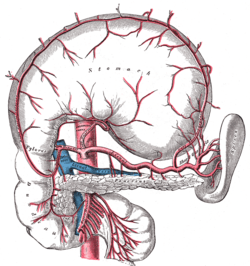Hepatic artery proper
| Artery: Hepatic artery proper | |
|---|---|
 | |
| The hepatic artery proper branches from the common hepatic artery. | |
 | |
| Inferior surface of the liver. (Entrance for hepatic artery labeled at bottom center.) | |
| Latin | arteria hepatica propria |
| Gray's | p.603 |
| Source | common hepatic artery |
The hepatic artery proper (also proper hepatic artery), arises from the common hepatic artery and runs alongside the portal vein and the common bile duct to form the portal triad. The hepatic artery proper gives off a small supraduodenal artery to the duodenal bulb. Then the right gastric artery comes off and runs to the left along the lesser curvature of the stomach to meet the left gastric artery, which is a branch of the celiac trunk. It subsequently bifurcates into the right and left hepatic arteries. Of note, the right and left hepatic arteries may demonstrate variant anatomy. A replaced right hepatic artery may arise from the superior mesenteric artery (SMA) and a replaced left hepatic artery may arise from the left gastric artery. The cystic artery generally comes off of the right hepatic artery. [1]
Additional images
-

Proper hepatic artery
-

The celiac artery and its branches; the stomach has been raised and the peritoneum removed.
-

The portal vein and its tributaries.
-

Abdominal portion of the sympathetic trunk, with the celiac and hypogastric plexuses.
-

Horizontal disposition of the peritoneum in the upper part of the abdomen.
-

Section across portal canal of pig. X 250.
-

The pancreatic duct.
-

Liver and gallbladder
References
- ↑ Balija M, Huis M, Nikolic V, Stulhofer M. Laparoscopic visualization of the cystic artery anatomy. World J Surg. 1999 Jul;23(7):703-7. PMID 10390590
External links
- Proper hepatic artery - Washington Hospital Center.
- Hepatic+artery+proper at eMedicine Dictionary
- 38:03-0104 at the SUNY Downstate Medical Center - "Stomach, Spleen and Liver: Contents of the Hepatoduodenal ligament"
- SUNY Anatomy Image 8329
- celiactrunk at The Anatomy Lesson by Wesley Norman (Georgetown University)
| |||||||||||||||||||||||||||||||||||||||||||||||||||||||||||||||||||||||||